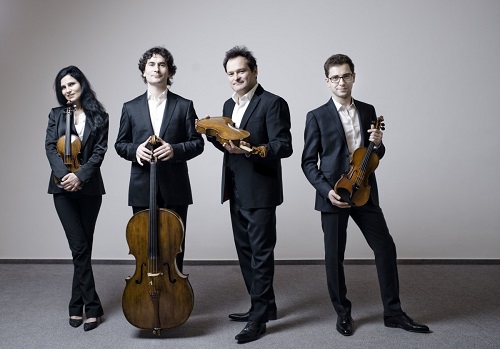 United Kingdom Haydn, Janáček, Shostakovich: Belcea Quartet (Corina Belcea, Axel Schacher [violins], Krzystof Chorzelski [viola] and Antoine Lederlin [cello]), Piotr Anderszewski (piano), Queen Elizabeth Hall, London, 30.4.2019. (CSa)
United Kingdom Haydn, Janáček, Shostakovich: Belcea Quartet (Corina Belcea, Axel Schacher [violins], Krzystof Chorzelski [viola] and Antoine Lederlin [cello]), Piotr Anderszewski (piano), Queen Elizabeth Hall, London, 30.4.2019. (CSa)

Haydn – String Quartet in G, Op.33 No.5
Janáček – String Quartet No.2 (Intimate Letters)
Shostakovich – Quintet in G minor for piano and strings, Op.57
It is something of an accomplishment for a small chamber ensemble to convey moments of soft intimacy and outbursts of barely contained emotion in a half-filled 916 seat Queen Elizabeth Hall. Yet, in a carefully chosen programme of miniature masterpieces by Haydn, Janáček, and Shostakovich, which spanned 150 years of musical history and required a vast range of interpretative skills, the Belcea Quartet and Piotr Anderszewski overcame all obstacles.
The concert began with an exquisitely nuanced account of Haydn’s String Quartet in G, Op.33 No 5, more familiarly known as the ‘How Do You Do?’ Quartet on account of the bows and curtsies suggested in its courtly opening theme. Written in 1781, the year that Austria forged a new treaty with Russia, the commercially astute Haydn dedicated his Op.33 quartets, including this one, to the Russian Grand Duke Paul Petrovich. This work is – on the surface at least – an elegant eighteenth-century exposition of rational discourse, but the Belcea, acutely sensitive to Haydn’s subversive humour, subtly underlined all its rhythmic and dynamic surprises, too. In the sprightly first movement, marked Vivace assai, the group struck the perfect balance between playfulness and tenderness, and rocked us gently in the serenely delicate second movement Largo. After a suitably impish account of the Scherzo, we were treated to a liltingly rhythmic Finale – a Sicilian pastoral dance which set the feet tapping.
After 20 minutes of civilised conversation with ‘Pappa’ Haydn, the raw emotional impact unleashed by the lovelorn Leoš Janáček’s Intimate Letters came as something of a shock to the system. Janáček was 62 years old when he met and fell madly in love with Kamila Stõsslová, a young married woman of 24 who had two children. Over the next 11 years, the composer penned her some 600 increasingly intimate letters, culminating in an outpouring of anguished creativity – his String Quartet No.2, eponymously named Intimate Letters and written just six months before his death in 1928. Janácek later confessed to Kamila that whereas the letters had been written ‘only in hot ash’, his musical missive was ‘written in fire’. Hovering on the edge of chaos, Janáček’s unconventional five movement quartet challenges the tonal and structural boundaries of the traditional medium and imposes seemingly conflicting demands on the players: tight group cohesion as well as individual virtuosity. The Belcea achieved these objectives in what can only be described as an elemental and finely balanced performance: one which transmitted the white heat of an impossible passion, tempered by moments of cool reflection.
In the second half of the evening, Piotr Anderszewski joined the string players to reprise Shostakovich’s Piano Quintet in G minor, Op.57 – which they first recorded together in June 2017 and since performed periodically. The Quintet was commissioned from the composer by the Beethoven Quartet in 1940 – less than a year before the Germans invaded Russia. Just as his Fifth Symphony, ironically entitled ‘An Artist’s Response to Just Criticism’, served as the vehicle for Shostakovich’s rehabilitation after official Stalinist censure, this quintet was officially ‘approved’ by the authorities. And like the Fifth Symphony, its ambiguities are open to numerous interpretations. From the piece’s opening moments, the Belcea and Anderszewski played with the greatest sensitivity, not only to the music but towards each other. It was a wonderful collaboration of great artists, reminiscent of the famous performance by Sviatoslav Richter and the Borodin Quartet. Recorded in 1982, the work opens with a homage to Bach, a Prelude followed by a complex second movement Fugue, initially hammered out on the piano and then joined by the disconsolate cry of the strings. The central Scherzo, a grimly jaunty Allegretto, was played slowly and with the necessary degree of deliberation, and the complex Finale, in which the carefree main theme struggles with elements of pain and anguish, was superbly balanced.
After an evening of unparalleled ensemble playing, and deep musical insight, Anderszewski went it alone on 3 May in a 50th birthday recital at London’s Wigmore Hall. The BBC were recording it, so catch it if you can.
Chris Sallon